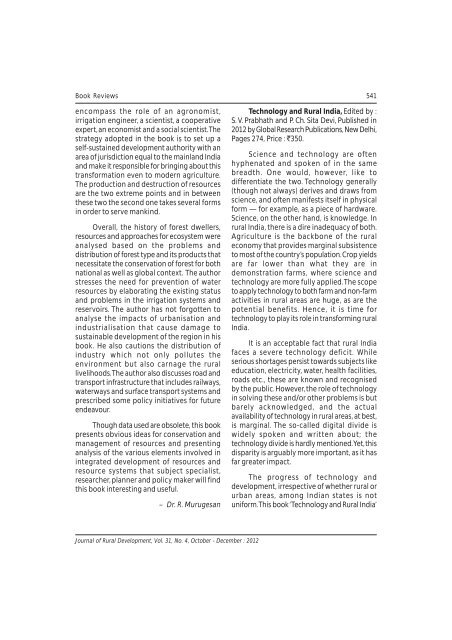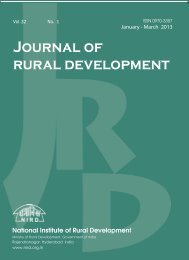October - December 2012 - National Institute of Rural Development
October - December 2012 - National Institute of Rural Development
October - December 2012 - National Institute of Rural Development
- No tags were found...
You also want an ePaper? Increase the reach of your titles
YUMPU automatically turns print PDFs into web optimized ePapers that Google loves.
Book Reviews 541encompass the role <strong>of</strong> an agronomist,irrigation engineer, a scientist, a cooperativeexpert, an economist and a social scientist. Thestrategy adopted in the book is to set up aself-sustained development authority with anarea <strong>of</strong> jurisdiction equal to the mainland Indiaand make it responsible for bringing about thistransformation even to modern agriculture.The production and destruction <strong>of</strong> resourcesare the two extreme points and in betweenthese two the second one takes several formsin order to serve mankind.Overall, the history <strong>of</strong> forest dwellers,resources and approaches for ecosystem wereanalysed based on the problems anddistribution <strong>of</strong> forest type and its products thatnecessitate the conservation <strong>of</strong> forest for bothnational as well as global context. The authorstresses the need for prevention <strong>of</strong> waterresources by elaborating the existing statusand problems in the irrigation systems andreservoirs. The author has not forgotten toanalyse the impacts <strong>of</strong> urbanisation andindustrialisation that cause damage tosustainable development <strong>of</strong> the region in hisbook. He also cautions the distribution <strong>of</strong>industry which not only pollutes theenvironment but also carnage the rurallivelihoods. The author also discusses road andtransport infrastructure that includes railways,waterways and surface transport systems andprescribed some policy initiatives for futureendeavour.Though data used are obsolete, this bookpresents obvious ideas for conservation andmanagement <strong>of</strong> resources and presentinganalysis <strong>of</strong> the various elements involved inintegrated development <strong>of</strong> resources andresource systems that subject specialist,researcher, planner and policy maker will findthis book interesting and useful.– Dr. R. MurugesanTechnology and <strong>Rural</strong> India, Edited by :S. V. Prabhath and P. Ch. Sita Devi, Published in<strong>2012</strong> by Global Research Publications, New Delhi,Pages 274, Price : `350.Science and technology are <strong>of</strong>tenhyphenated and spoken <strong>of</strong> in the samebreadth. One would, however, like todifferentiate the two. Technology generally(though not always) derives and draws fromscience, and <strong>of</strong>ten manifests itself in physicalform — for example, as a piece <strong>of</strong> hardware.Science, on the other hand, is knowledge. Inrural India, there is a dire inadequacy <strong>of</strong> both.Agriculture is the backbone <strong>of</strong> the ruraleconomy that provides marginal subsistenceto most <strong>of</strong> the country’s population. Crop yieldsare far lower than what they are indemonstration farms, where science andtechnology are more fully applied. The scopeto apply technology to both farm and non-farmactivities in rural areas are huge, as are thepotential benefits. Hence, it is time fortechnology to play its role in transforming ruralIndia.It is an acceptable fact that rural Indiafaces a severe technology deficit. Whileserious shortages persist towards subjects likeeducation, electricity, water, health facilities,roads etc., these are known and recognisedby the public. However, the role <strong>of</strong> technologyin solving these and/or other problems is butbarely acknowledged, and the actualavailability <strong>of</strong> technology in rural areas, at best,is marginal. The so-called digital divide iswidely spoken and written about; thetechnology divide is hardly mentioned. Yet, thisdisparity is arguably more important, as it hasfar greater impact.The progress <strong>of</strong> technology anddevelopment, irrespective <strong>of</strong> whether rural orurban areas, among Indian states is notuniform. This book ‘Technology and <strong>Rural</strong> India’Journal <strong>of</strong> <strong>Rural</strong> <strong>Development</strong>, Vol. 31, No. 4, <strong>October</strong> - <strong>December</strong> : <strong>2012</strong>

















